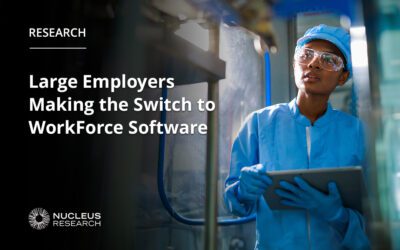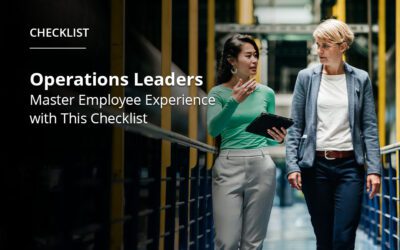Preventing “The Great Resignation” in Your Workforce with AI-Powered Insights


Marc Gingras
SVP, Employee Experience Strategy
In 2019, the World Health Organization declared burnout—a state of physical or emotional exhaustion caused by prolonged stress—an occupational phenomenon affecting workers’ health. Recent polls suggest that as many as three out of four workers are experiencing burnout on the job.
Additionally, a recent survey found that employers and employees are misaligned on key issues like job training, scheduling flexibility and pay rates, which negatively impacts the employee experience and further exacerbates employee’s perceptions of their workplace.
High levels of stress not only affect an individual’s health and personal well-being—they also affect how an organisation operates, leading to:
- Lower levels of productivity
- Increased injuries on the job
- Lower job satisfaction
As a result, workers are changing or quitting jobs in search of higher wages, a better work-life balance, increased flexibility of work locations and schedules, more job opportunities, and less stress in what’s been dubbed “the great resignation.” A recent survey by Microsoft suggests that 41% of employees are expected to change roles this year.
AI to the Rescue
Ongoing advancements in data availability, natural language processing, optimisation, and machine learning are alleviating the burden placed on budget and time-constrained HR departments and frontline managers. Technology is helping them proactively identify signs of employee burnout, distress, and lower job satisfaction by surfacing insights on attendance, scheduling preferences and employee sentiment so HR teams can make data-informed decisions that improve the employee experience.
Here are some of the ways employers can use workforce management software and AI to assess employee satisfaction and to better the employee experience.
Data-Driven and Data-Informed
Due to our always-on culture and workplace expectations, staff can be hesitant about raising concerns about their schedules, workload, personal and professional priorities, and the overall experience they’re having at work—and opt for leaving their job entirely.
Instead, workforce management software can track data on scheduling, time and attendance data, employee sentiment, and other information that’s difficult to parse through, and changes in behavior or workplace dissatisfaction can be identified and dealt with early on.
Data on paid leave can signify whether an employee is getting enough time away from a job to avoid burnout. AI could alert a manager to find space in the employee’s schedule to take time off and recharge.
Time and attendance and scheduling data can indicate that an employee is dissatisfied at work—say, if the data shows they’re repeatedly showing up to work late with no previous pattern of tardiness, or if their schedule is frequently changed by management less than two days before a shift, or they’re being asked to work additional unwanted weekends.
By surfacing this data, along with additional info from HR systems—like when an employee last received a pay raise or completed a peer review—AI can provide employers with insights on the current state of an employee’s experience and whether changes need to be made to better support and engage them.
The Future of AI and Workforce Management
Advancements in AI are making it easier for organisations to increase efficiency and streamline human resource management with greater focus surfaced through data and proactive interventions from managers.
AI can also be used to identify undesirable shifts and incentives that might make them more desirable to workers. Based on how often shifts are swapped, employees call in sick, or employee sentiment on workloads during certain shifts, organisations could optimise scheduling to fairly distribute hours, identify more desirable pay rates or other offers to ensure shifts are covered and employee sentiment remains high.
Similarly, AI will identify negative changes or trends in individual employee productivity or attendance patterns—such as an unusual spike in lateness, either organisation-wide or with individual employees. Software can automatically send a pulse survey to assess the reasons why (maybe peak traffic periods are affecting employees’ commutes or personal obligations, like school drop-offs and pick-ups, are making it harder to report for work on time) and share the insights with the manager or human resources team so they can make scheduling and staffing changes accordingly.
Advancements in natural language processing could also allow HR practitioners to utilise chatbots and assistants to solve scheduling problems, process time-off requests and assess employee sentiment about their workload, safety issues on the job site, feelings on repetitive or low-value tasks, or the effectiveness of shift managers and leaders, and surface insights if a change needs to be made at an organisational or operational level.
Using AI to Accelerate Emotionally Intelligent Decision Making
Improper workforce management practices affect job satisfaction and often contribute to an employee leaving an organisation. Those who don’t consider employees’ needs and invest in technology that enhances the employee experience risk losing more staff in the future.
Although AI was once feared for its ability to make certain jobs redundant, if anything, it’s enabled employers to make more human decisions, according to HR Tech Influencer Tyrone Smith Jr., who says analytic tools designed to promote active listening and predictive responses can highlight potential trouble and help organisations better support employees.
As with any technological advancements, there are specific data and privacy laws, rules and regulations, employment rights and ethical quandaries to consider when it comes to AI. But, when executed properly, AI can free up the human workforce needed to perform manual, time-consuming tasks and leverage insights into employee’s day-to-day experiences that would otherwise be difficult to glean, giving HR teams and managers more opportunities to connect with and support employees in meaningful ways.
By surfacing insights on attendance, scheduling preferences, and employee sentiment to assess whether an employee is dissatisfied, overworked, or ready to quit, AI can help HR professionals engage talent and improve job satisfaction while future-proofing their organisation against further employee churn. With millions across the globe considering a career move, every employee (and experience they receive at work) counts.
Start gaining further insights and learn about technology solutions to improve your organization’s employee experience.
This is an edited and condensed version of an article that appeared in theHRDIRECTOR.
Subscribe to The WorkForce Blog
Learn the art and science of maintaining productive, happy, engaged employees.
Discover More
Nucleus Insights from WorkForce Customers Research Note
Nucleus Research interviews WorkForce customers who validate why we’re ranked the #1 WFM enterprise vendor for 10 consecutive years.
Elevate Employee Experience: Checklist for Operational Leaders
Get the practical steps and technology functionalities operation leaders need to improve their employees’ work experiences.
Streamlining Complex Workforce Compliance Requirements Boosts Productivity
Discover how workforce compliance software helps EMEA organisations navigate complex legislation, enhance compliance and boost operational efficiency.



